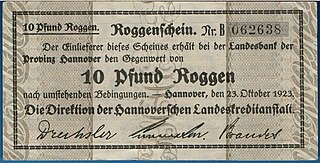Hannoversche Landeskreditanstalt
The Hannoversche Landeskreditanstalt (HLKA) (also: Hannoversche Landesbank ) was a bank founded in the Kingdom of Hanover in the 19th century in connection with the peasant liberation . The institution merged in 1970 in the NORD / LB .
history
The Hannoversche Landeskreditanstalt was brought into being by law to end the manorial rule in the Kingdom of Hanover, after the Redemption Act of October 10, 1831 and the Redemption Ordinance of July 23, 1833 had been passed. The bank was to provide the hereditary peasants on their farms with the necessary loans that the peasants needed to relieve their burdens from their landlords .
The intended lending represented a difference to the peasant exemption in Prussia : The burdens of the peasants in the Kingdom of Hanover should not be relieved by the cession of land , rather the farms should be retained for tax reasons, both in their size and, if possible, in their profitability .
On January 15, 1841, the Hannoversche Landeskreditanstalt went into operation and, barely a quarter of a century later, around 1865, the redemption of 76.5 percent of all the peasants' burdens in the kingdom was a success. The institute's field of activity expanded very quickly, so that soon all goods, farms and property in the agricultural sector could be mortgaged.
After the annexation of the Hanoverian Kingdom by Prussia , the “Provincial Association” was founded in the now Prussian province of Hanover in 1867 and in 1869 the classification of the HLKA and its lending were regulated by law.

After the end of World War I and the German Empire , the Hannoversche Landeskreditanstalt beginning who saw the Weimar Republic on the one hand a decline in production in agriculture over and thus an increased need for infrastructure - investments . On the other hand, the German hyperinflation narrowed the scope of the institution more and more, so that the HLKA in 1923/24 was forced to issue bonds on the basis of rye .
After the time of National Socialism and the Second World War , the Landeskreditanstalt, which still granted its own loans, was included in the handling of public sector measures . For example, special loans were granted to integrate refugees and displaced persons and a program to improve the agricultural structure was carried out.
On July 1, 1970, Lower Saxony's finance minister and later Prime Minister Alfred Kubel initiated the founding of NORD / LB. The former in-house counsel and chairman of the board of HLKA, Wilhelm Pracht , accompanied the difficult negotiations for this merger of the Hannoversche Landeskreditanstalt with the Braunschweigische Staatsbank , the Niedersächsische Wohnungskreditanstalt Stadtschaft and the Niedersächsische Landesbank Girozentrale to form NORD / LB and became their first chairman of the board.
Personalities
- Otto Biedenweg; 1879 Bank director and builder of the Biedenweg house built by Heinrich Köhler in 1879 at Prinzenstrasse 17
literature
- Karl Heinz Schneider, Hans Heinrich Seedorf: Peasant liberation and agricultural reforms in Lower Saxony , in the series of writings on home care , Volume 4, ed. vom Niedersächsischer Heimatbund , Hildesheim: Lax, 1989, ISBN 3-7848-5104-5 , pp. 60-75.
- NORD / LB (publisher): 30 years of NORD / LB. A young bank with a long tradition , Hanover, 2000, pp. 45–56.
- Rainer Ertel , Waldemar R. Röhrbein : Hannoversche Landeskreditanstalt. In: Klaus Mlynek, Waldemar R. Röhrbein (eds.) U. a .: City Lexicon Hanover . From the beginning to the present. Schlütersche, Hannover 2009, ISBN 978-3-89993-662-9 , p. 260 f.
Web links
- Literature from and about Hannoversche Landeskreditanstalt in the portal of the German National Library
- Early documents and newspaper articles on Hannoversche Landeskreditanstalt in the 20th century press kit of the ZBW - Leibniz Information Center for Economics .
Individual evidence
- ↑ a b c d e f g h i Rainer Ertel, Waldemar R. Röhrbein: Hannoversche Landeskreditanstalt (see literature)
- ↑ see the bank's rye bond from 1923.
- ^ Waldemar R. Röhrbein: 1970. In: Hannover Chronik , p. 265f .; online through google books.
- ^ Klaus Mlynek : Kubel, Alfred. In: Stadtlexikon Hannover , p. 373.
- ^ A b Waldemar R. Röhrbein: PLEISTER, Wilhelm. In: Dirk Böttcher, Klaus Mlynek, Waldemar R. Röhrbein, Hugo Thielen: Hannoversches Biographisches Lexikon . From the beginning to the present. Schlütersche, Hannover 2002, ISBN 3-87706-706-9 , pp. 287f .; online through google books .
- ↑ Helmut Knocke , Hugo Thielen : Prinzenstrasse 17 , in Dirk Böttcher , Klaus Mlynek (ed.): Hannover. Kunst- und Kultur-Lexikon (HKuKL), new edition, 4th, updated and expanded edition, zu Klampen, Springe 2007, ISBN 978-3-934920-53-8 , p. 184

